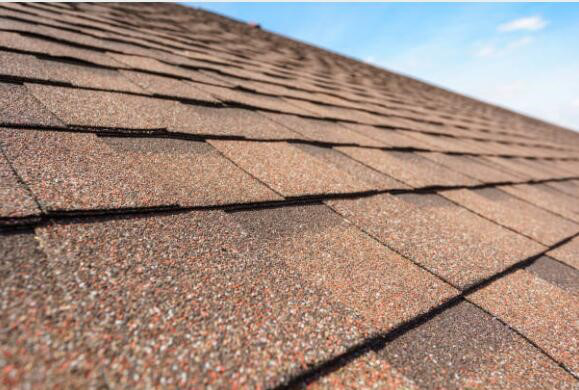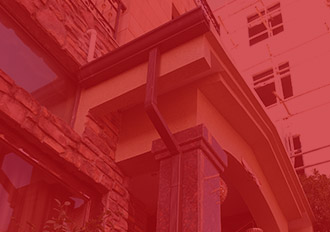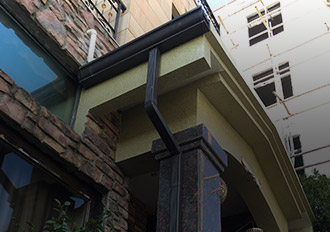THE LATEST IN ROOFING
For many homeowners, the cheapest option is always the default choice while others choose a style they like and leave the details to a contractor. But the impact of our roofing choices, both on our homes and on the environment, is too great to ignore. We’ve researched roofing materials to make buying an eco-friendly roof easier.
Materials
Asphalt is the cheapest option. It is so common that many people assume you are talking about asphalt shingles when you talk about roofing.
Laminate shingles (also called architectural or dimensional) are fiberglass layered between asphalt and ceramic granules. They can be made to look like more expensive materials, such as tile, wood, and slate. Although slightly more expensive than basic three-tab asphalt shingles, laminate shingles perform better. Single-plane shingle roofs (also called 3-tab) are the easiest roof to retrofit with a solar panel system.
Asphalt roofs usually last 20 to 25 years, but some newer, high-quality products will last 40 years or more. Although technically recyclable, most asphalt roof shingles end up in the landfill.
2.Wood Shingle and Shake
Prized for their natural look, handmade shakes have earned their reputation for being expensive, but machine-made wooden shingles do not cost much more than asphalt. Wood shingles can mold, split, or rot in wet climates.
Untreated wood shakes are unrated for fire safety and therefore are not permitted by building codes in many areas prone to wildfires. Fire retardants can help wood shingles and shakes achieve a Class B fire rating. Including additional materials in the roof assembly can help them meet a Class A rating. Despite these vulnerabilities, wood roofs can last 25 to 30 years. Meticulous maintenance and mild climates can extend the lifespan to 50 years.
3.Metal
Metal roofing options include steel, aluminum, copper, and alloy strips. They come in various shapes and textures, from standing seam panels to shingles that resemble tile or slate. Metal can be more expensive than asphalt, but except for copper, it is still among the cheaper roofing options. Proper installation and good insulation are required to minimize noise from rainfall and wind “chatter.” Metal is lightweight, virtually fireproof, and particularly suited to thin-film solar power systems. Metal roofs last at least 40 years and can last as long as 75 years. They are also the most easily recycled roofing material.
4.Tile
Tile roofs dominate the Mission- and Spanish-style homes of the U.S. West and Southwest. Although they are more common in desert areas, some tiles are suitable for use in cold climates. Roof tiles can be made from true terracotta clay, ceramic, or concrete. Tile roofs are very heavy and may require additional framing. Concrete is cheaper than clay but has many of the same advantages. Tile roofs last 40 to 50 years on average but have been known to last up to a century.
5.Slate
Slate roofs are heavy enough to require extra framing. As arguably the most expensive roofing material, they are not an option for most budgets. But they are also nearly indestructible, with a lifespan of 50 to 100 years or more. Be aware of the origin of the slate that will be used, as the sustainability and durability can vary. Because slate is so heavy, the distance slate tiles must be shipped will significantly affect not only the cost but the environmental impact of choosing this natural material.
6.Synthetic Roofing
Synthetic roofing can be made from a variety of materials, such as plastic, clay, rubber, or asphalt. And it is usually designed to resemble natural materials like slate or wood. Few synthetic materials have been around long enough to gauge their long-term performance. But several demonstrate promise, with high ratings in performance tests and warranties of 50 years.
Roofing Rating Criteria
Longevity
The lifespan of your roof is largely a function of material choice. Slate roofing will last the longest, on average, and wood or 3-tab asphalt shingles have the shortest average lifespan. However, individual products can be manufactured to higher standards. So, a very good asphalt roof may last as long as an average metal one. For our comparison of manufactured roofs, we started with metal roofs ranked highest, followed by tile and then asphalt.
Energy Efficiency
The radiative properties of roofing materials are solar reflectance and thermal emittance. Both are rated on a scale of 0 to 1, where 1 is the most reflective or emissive. A cool roof can reduce cooling energy costs by 7-15 percent, minimize temperature fluctuations inside the home, and reduce the urban heat island effect. Roof products have a solar reflectance of at least .65 for low-slope roofs and .25 for high slope roofs. High solar reflectance is the most important characteristic for saving energy during warmer months. High emissivity can also help reduce cooling costs in hot climates but may not be as desirable in cold ones.
Solar panels can be mounted to almost any roof, but manufacturers offering a solar-integrated roofing system got a boost in the ranking.
Recycling Practices
All of the roofing materials we considered are technically recyclable.




REQUEST A QUOTE
Copyright © Hangzhou Singer Building Materials Co., Ltd. All Rights Reserved |
Sitemap
| Powered by 
SEOKeywords:Roof Tile ManufacturerRoof Shingle ManufacturerAsphalt Shingle SupplierRain Gutter CompanyShingle Roofing CompanyWaterproof Tape For RoofPressed Steel Roofing TilesRain Gutter SystemGray Asphalt ShingleStone Coated Metal Roofing Manufacturer